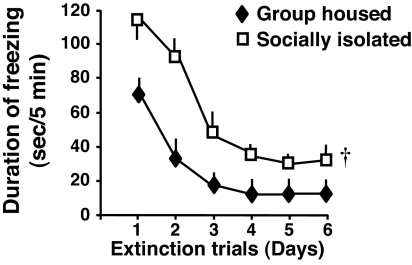Fig. 3.
Extinction of contextual freezing behavior is impaired in socially isolated mice. Contextual freezing time was measured for six consecutive days starting 24 h after the training session. During the extinction trials, mice were reexposed daily to the conditional context without receiving footshocks. Two-way repeated measures ANOVA with factors for housing, time, and their interactions with the duration of freezing time revealed that mice socially isolated for 3 weeks expressed an overall higher duration of freezing time compared with group housed mice. †, P < 0.01 (two-way repeated measures ANOVA, followed by Bonferroni comparison). The slope values for the extinction curve (expressed in percentage of total duration of freezing time) during the first 3 days of the extinction trials were calculated for each mouse. The results show a delayed extinction in socially isolated compared with group housed mice (slope values: group housed, −41.0 ± 2.2; socially isolated, −27.2 ± 5.2, mean ± SEM; n = 5; P = 0.04, Student's t test).

